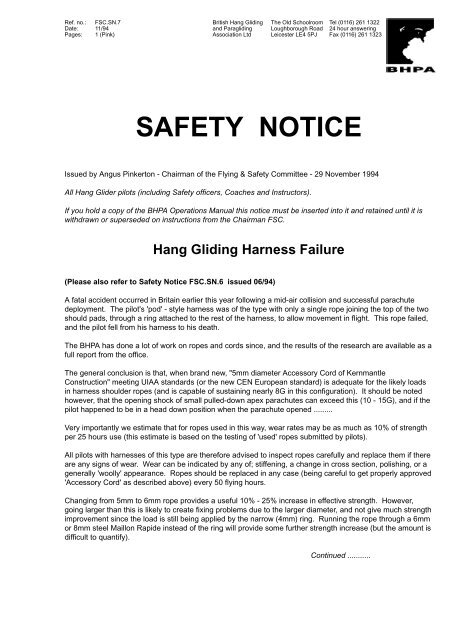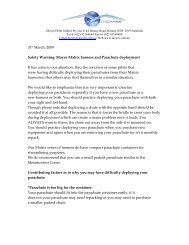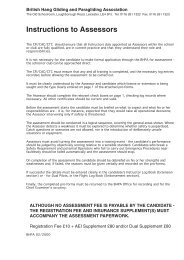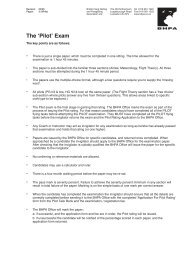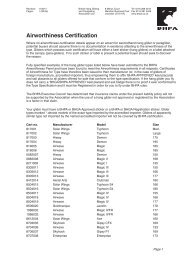SAFETY NOTICE - British Hang Gliding and Paragliding Association
SAFETY NOTICE - British Hang Gliding and Paragliding Association
SAFETY NOTICE - British Hang Gliding and Paragliding Association
You also want an ePaper? Increase the reach of your titles
YUMPU automatically turns print PDFs into web optimized ePapers that Google loves.
Ref. no.: FSC.SN.7<br />
Date: 11/94<br />
Pages: 1 (Pink)<br />
<strong>British</strong> <strong>Hang</strong> <strong>Gliding</strong><br />
<strong>and</strong> <strong>Paragliding</strong><br />
<strong>Association</strong> Ltd<br />
The Old Schoolroom<br />
Loughborough Road<br />
Leicester LE4 5PJ<br />
Tel (0116) 261 1322<br />
24 hour answering<br />
Fax (0116) 261 1323<br />
<strong>SAFETY</strong> <strong>NOTICE</strong><br />
Issued by Angus Pinkerton - Chairman of the Flying & Safety Committee - 29 November 1994<br />
All <strong>Hang</strong> Glider pilots (including Safety officers, Coaches <strong>and</strong> Instructors).<br />
If you hold a copy of the BHPA Operations Manual this notice must be inserted into it <strong>and</strong> retained until it is<br />
withdrawn or superseded on instructions from the Chairman FSC.<br />
<strong>Hang</strong> <strong>Gliding</strong> Harness Failure<br />
(Please also refer to Safety Notice FSC.SN.6 issued 06/94)<br />
A fatal accident occurred in Britain earlier this year following a mid-air collision <strong>and</strong> successful parachute<br />
deployment. The pilot's 'pod' - style harness was of the type with only a single rope joining the top of the two<br />
should pads, through a ring attached to the rest of the harness, to allow movement in flight. This rope failed,<br />
<strong>and</strong> the pilot fell from his harness to his death.<br />
The BHPA has done a lot of work on ropes <strong>and</strong> cords since, <strong>and</strong> the results of the research are available as a<br />
full report from the office.<br />
The general conclusion is that, when br<strong>and</strong> new, "5mm diameter Accessory Cord of Kernmantle<br />
Construction" meeting UIAA st<strong>and</strong>ards (or the new CEN European st<strong>and</strong>ard) is adequate for the likely loads<br />
in harness shoulder ropes (<strong>and</strong> is capable of sustaining nearly 8G in this configuration). It should be noted<br />
however, that the opening shock of small pulled-down apex parachutes can exceed this (10 - 15G), <strong>and</strong> if the<br />
pilot happened to be in a head down position when the parachute opened .........<br />
Very importantly we estimate that for ropes used in this way, wear rates may be as much as 10% of strength<br />
per 25 hours use (this estimate is based on the testing of 'used' ropes submitted by pilots).<br />
All pilots with harnesses of this type are therefore advised to inspect ropes carefully <strong>and</strong> replace them if there<br />
are any signs of wear. Wear can be indicated by any of; stiffening, a change in cross section, polishing, or a<br />
generally 'woolly' appearance. Ropes should be replaced in any case (being careful to get properly approved<br />
'Accessory Cord' as described above) every 50 flying hours.<br />
Changing from 5mm to 6mm rope provides a useful 10% - 25% increase in effective strength. However,<br />
going larger than this is likely to create fixing problems due to the larger diameter, <strong>and</strong> not give much strength<br />
improvement since the load is still being applied by the narrow (4mm) ring. Running the rope through a 6mm<br />
or 8mm steel Maillon Rapide instead of the ring will provide some further strength increase (but the amount is<br />
difficult to quantify).<br />
Continued ...........
It is very important to make sure that knots are of the correct type, <strong>and</strong> secure. Tapes are only as strong as<br />
the knots securing them! If you have any doubt whatsoever about your knot tying knowledge or skill, get<br />
help.<br />
A better answer, if the harness manufacturer is still in business, is to get them to change the design to<br />
eliminate the single point failure inherent in the 'sliding-rope-through-a-ring' shoulder support. This should be<br />
retained as the primary support, but with sewn in tapes as a backup, for example.<br />
Please exercise great caution if you are tempted to make any DIY harness modifications.


